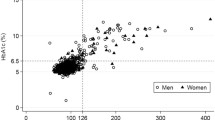Abstract
The metabolic syndrome (MS) leads to serious health problems like diabetes and has serious economic consequences for multinational companies. Thus, the workplace is an important setting for primary prevention. Aim of this study was to evaluate the prevalence of MS in a mixed working population to provide a basis for interventional strategies. In 2006, 1,594 employees attended a screening program at BASF Ludwigshafen, the number of employees with MS was determined and the distribution of impaired glucose tolerance (IGT), type 2 diabetes and cardiovascular disease (CVD) analyzed. The study-population consisted of 1,075 men and 519 women, aged 17–64. 374 individuals (23.5%) were classified to be affected by MS, of which 86.9% were male (prevalence MS in men 30%, in women 9.7%). Subjects with MS had higher BMI (P < 0.01), blood pressure (P < 0.01), heart rate (P < 0.01), liver enzymes (P < 0.01), uric acid (P < 0.01) and LDL (P < 0.01), while HDL was significantly lower (P < 0.01). (Pre)-Diabetes and CVD were found more frequently in subjects with MS. There were no significant differences between individuals with different types of employment (“white collar vs. blue collar” workers) or smoking status. We found a high prevalence of MS in our working population, thus interventional programmes should be implemented. The workplace-setting can be used to promote long-term prevention strategies in this adult working population.
Similar content being viewed by others
References
Eckel RH, Grundy SM, Zimmet PZ (2005) The metabolic syndrome. Lancet 365:1414–1428
Cameron AJ, Shaw JE, Zimmet PZ (2004) The metabolic syndrome: prevalence in worldwide populations. Endocrinol Metabo Clin N Am 33:351–376
Isomaa B, Almgren P (2001) Cardiovascular morbidity and mortality associated with the metabolic syndrome. Diabetes Care 24(4):683–689
Hertz RP, Unger AN (2004) The impact of obesity on work limitations and cardiovascular risk factors in the US workforce. J Occup Environ Med 46(12):1196–1203
International diabetes federation (2005) The IDF consensus worldwide definition of the metabolic syndrome. Brussels: IDF. Available at: http://www.idf.org/webdata/docs/IDF_Metasyndrome_definition.pdf (accessed May 2005)
Alberti KG, Zimmet P, Shaw J (2005) IDF Epidemiology task force consensus group. The metabolic syndrome–a new worldwide definition Lancet 24–30;366(9491):1059–1062
Working toward wellness—World Economic Forum (2006) Extracted and calculated from http://laborsta.ilo.org/cgi-bin/brokerv8.exe#468 on 11 December 2006
Lindström J, Tuomilehto J (2003) The diabetes risk score—a practical tool to predict type 2 diabetes risk. Diabetes Care 26:725–731
Expert committee on the diagnosis and classification of diabetes mellitus. follow-up report on the diagnosis of diabetes mellitus (2003) Diabetes Care 26(11):3160–3167
National Center for chronic disease prevention and health promotion—national diabetes fact sheet: http://www.cdc.gov/diabetes/pubs/general.htm
Park YW, Zhu S, Palaniappan L, Heshka S, Carnethon MR, Heymsfield SB (2003) The metabolic syndrome: Prevalence associated risk factor findings in the US population from the third national health and nutrition survey, 1998–1994. Arch Intern Med 163:427–436
Godefroi R, Klementowitcz P (2005) Metabolic syndrome in a screened worksite sample: prevalence and predictors. Cardiology 103(3):131–136
Gesundheitsberichterstattung des Bundes „Gesundheit in Deutschland”: (Online Artikel)—Aufgerufen am 06.12.2006 http://www.rki.de/cln_011/nn_1001054/DE/Content/GBE/Gesundheitsberichterstattung/GesInDtld/gesundheitsbericht,templateId=raw,property=publicationFile.pdf/gesundheitsbericht
Sabinsky MS, Toft U, Raben A, Holm L (2006) Overweight men’s motivations and perceived barriers towards weight loss. Eur J Clin Nutrit 61(4):526–531
Zober A, Schilling D, Ott MG, Schauwecker P, Riemann JF, Messerer P (1998) Helicobacter pylori infection: PREVALENCE, clinical relevance in a large company. J Occup Environ Med 40:586–594
Webendorfer S, Messerer P, Eberle F, Zober A (2004) Precautions for intestinal cancer in the workplace. An initiative for secondary prevention in the BASF joint-stock company. Dtsch Med Wochenschr 129:239–243
Buck H, Kistler E, Mendius HG: Demographic change in the World of Work (2002) Bundesministerium für Bildung und Forschung. Stuttgart. ISBM:3-8167-5180-1
Metabolic syndrome and employer sponsored medical benefits: an actuarial analysis—http://www.dfwbgh.org/events06/Milliman%20Report.pdf
Author information
Authors and Affiliations
Corresponding author
Rights and permissions
About this article
Cite this article
Oberlinner, C., Humpert, P.M., Nawroth, P.P. et al. Metabolic syndrome in a large chemical company: prevalence in a screened worksite sample. Acta Diabetol 45, 31–35 (2008). https://doi.org/10.1007/s00592-007-0015-6
Received:
Accepted:
Published:
Issue Date:
DOI: https://doi.org/10.1007/s00592-007-0015-6




